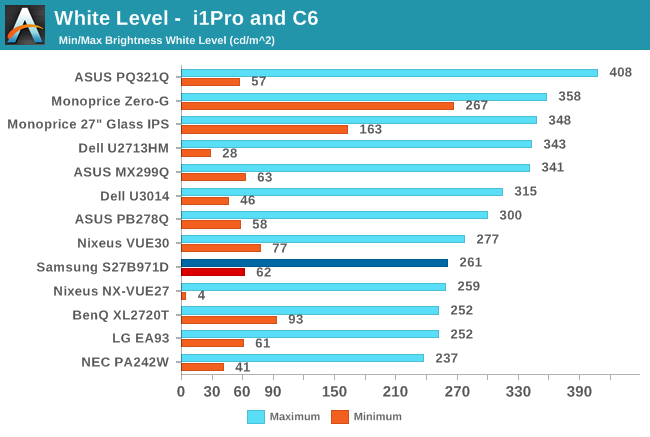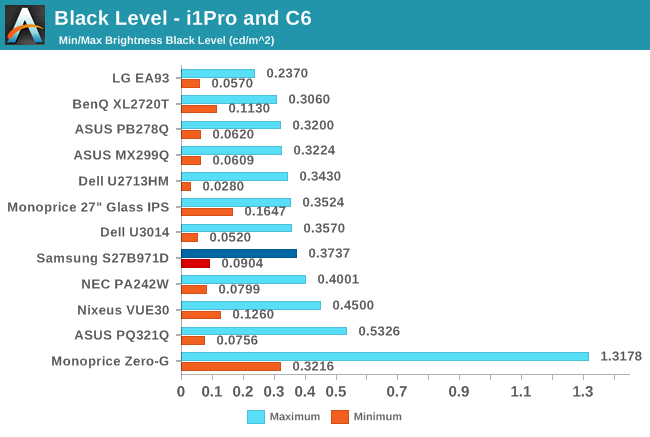Samsung S27B971D Monitor Review
by Chris Heinonen on October 31, 2013 12:00 PM ESTThe maximum light output of the S27B971D is only rated for 250 cd/m^2 in the Standard mode, which is lower than we expect to see. For all these pre-calibration measurements I use the sRGB mode of the display. It is the most accurate out of the box and what I would use if I couldn’t calibrate the display.
With the brightness set to maximum we get 261 cd/m^2 of brightness on a white screen. This is slightly more than the specs say, which is nice to see, but 10 nits is a pretty small difference. Set down to the minimum we get 62 cd/m^2 which is a good range of brightness. Many displays stop well before 100 cd/m^2 which can be too bright for nighttime or light controlled environments. If you do use the high brightness mode you can get 321 cd/m^2 from the S27B971D, but you give up accuracy. I’d skip it, unless there was a specific instance where it was helpful.

As PLS is similar to IPS I expect to see black level results that more closely mirror it than a VA style panel. The black levels on the Samsung are a bit underwhelming. With the backlight at maximum the black level is 0.3737 cd/m^2; at minimum it is 0.0904 cd/m^2. With values like this I’d like to see a higher white level as the contrast levels are going to be only fair.

As I suspected the contrast levels on the Samsung are only 700:1 and 690:1. These are OK for an IPS/PLS panel but not amazing. Samsung rates the display at 1,000:1 for static contrast but I didn’t find a way to achieve those numbers unless you use the dynamic contrast system (which I don’t). So it's a fair result but not great.











52 Comments
View All Comments
Bateluer - Thursday, October 31, 2013 - link
Meh, the DisplayPort and HDMI are nice, but I paid less than that for two 27in WQHD displays a year ago. Samsung, get this to a 4K resolution and you'll have buyers in 2014.TridenT - Thursday, October 31, 2013 - link
Typo in your second graphic: 1iProLolimaster - Friday, November 1, 2013 - link
And fix the awefull contrast, 500:1? What a joke.Minimum 1000-1100:1
cheinonen - Sunday, November 3, 2013 - link
The lower contrast will hurt performance for games and movies, yes. Typically on a display like this that is the trade-off to have a more uniform overall screen with a more controlled backlight. For many environments (graphic design, photography) the uniformity and color accuracy are both more essential than the contrast ratio.lkuzmanov - Friday, November 1, 2013 - link
Does anyone know why displays aren't being factory calibrated? Surely it must be technically possible.cheinonen - Sunday, November 3, 2013 - link
It is. Look at the recent NEC PA242W for an example. However that is a 24", 1920x1200 display that sells for over $1,100, so you are paying for that calibration.DaveGirard - Friday, November 1, 2013 - link
This looks like a great display for CG people where colour profiles are still AWOL with apps like ZBrush, Mudbox, etc. They assume you're using sRGB. But you still want a high-quality display. That said, it is a bit pricey compared to the dual Dell U2713HM monitors that I'm running quite happily.abhijeeth - Friday, November 1, 2013 - link
This is indeed slotted in a narrow niche: would have been so much better if it had support for AdobeRGB.The NEC PA271W can be purchased new at B&H Photo for $859 (no Spectraview + Calibrator bundle). But it is so good out of the box that you don't need an external calibrator. Downside is that is is CCFL and some units have an audible high pitched whine when high contrast images are displayed.
The NEC PA272W is just launched and will be available in the US on Nov 18th for $1299. LED Backlight, wide gamut coverage takes care of Adobe RGB requirements. Good warranty and dead pixel policy.
There is also the ASUS PA279Q for around $850 (wide Gamut). Pre Cal numbers aren't outstanding out of the box (dE < 2 claimed) but cleans up after post calibration. Has overshoot ghosting though.
Then there is the ViewSonic VP2772 for $990 (wide Gamut support).
In the 30inchers, the Dell U3014 is frequently on sale for $940ish. Can get a refurb directly from Dell for $640. Have to get Rev A03 though ;-)
There is the new HP Z30i (wide Gamut) for $1299.
All the new ones use LG's new semi glossy (satin/pearl finish) coating and not the grainy coatings of old 1st gen panels (the PA271W falls into this category unfortunately)
Having considered all this, the Samsung is indeed overpriced for what it offers. Stiff competition all around.
Alan G - Friday, November 1, 2013 - link
This monitor is dead in the water for anyone doing photography who needs an expanded color gamut. There's a reason why NEC monitors are the goto here. I don't care about how easy it is to use the OSD; I'm using software calibration.abhijeeth - Friday, November 1, 2013 - link
Alan,Agreed. By software calibration - are you using software to write to your video card LUT or the 14bit 3axis LUT inside the monitor. The interface bit depth is different (8 or 10bit per color depending on interface used) to the internal bit depth for storing the color info.
Using the monitor internal LUT has significant advantages for Color Management. ( you may be already aware of this, so, sorry if this is redundant). Just thought it might be worth mentioning.